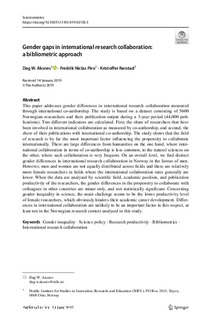| dc.contributor.author | Aksnes, Dag W. | |
| dc.contributor.author | Piro, Fredrik | |
| dc.contributor.author | Rørstad, Kristoffer | |
| dc.date.accessioned | 2019-06-28T08:19:41Z | |
| dc.date.available | 2019-06-28T08:19:41Z | |
| dc.date.created | 2019-06-27T14:24:27Z | |
| dc.date.issued | 2019-06-13 | |
| dc.identifier.citation | Aksnes, D. W., Piro, F. N. & Rørstad, K. (2019). Gender gaps in international research collaboration: a bibliometric approach. Scientometrics, 1-28. | nb_NO |
| dc.identifier.issn | 0138-9130 | |
| dc.identifier.uri | http://hdl.handle.net/11250/2602718 | |
| dc.description.abstract | This paper addresses gender differences in international research collaboration measured through international co-authorship. The study is based on a dataset consisting of 5600 Norwegian researchers and their publication output during a 3-year period (44,000 publications). Two different indicators are calculated. First, the share of researchers that have been involved in international collaboration as measured by co-authorship, and second, the share of their publications with international co-authorship. The study shows that the field of research is by far the most important factor influencing the propensity to collaborate internationally. There are large differences from humanities on the one hand, where international collaboration in terms of co-authorship is less common, to the natural sciences on the other, where such collaboration is very frequent. On an overall level, we find distinct gender differences in international research collaboration in Norway in the favour of men. However, men and women are not equally distributed across fields and there are relatively more female researchers in fields where the international collaboration rates generally are lower. When the data are analysed by scientific field, academic position, and publication productivity of the researchers, the gender differences in the propensity to collaborate with colleagues in other countries are minor only, and not statistically significant. Concerning gender inequality in science, the main challenge seems to be the lower productivity level of female researchers, which obviously hinders their academic career development. Differences in international collaboration are unlikely to be an important factor in this respect, at least not in the Norwegian research context analysed in this study. | nb_NO |
| dc.language.iso | eng | nb_NO |
| dc.publisher | Springer | nb_NO |
| dc.rights | Navngivelse 4.0 Internasjonal | * |
| dc.rights.uri | http://creativecommons.org/licenses/by/4.0/deed.no | * |
| dc.subject | Gender inequality | nb_NO |
| dc.subject | Science policy | nb_NO |
| dc.subject | Research productivity | nb_NO |
| dc.subject | Bibliometrics | nb_NO |
| dc.subject | International research collaboration | nb_NO |
| dc.title | Gender gaps in international research collaboration: a bibliometric approach | nb_NO |
| dc.type | Journal article | nb_NO |
| dc.type | Peer reviewed | nb_NO |
| dc.description.version | publishedVersion | nb_NO |
| dc.source.pagenumber | 28 | nb_NO |
| dc.source.journal | Scientometrics | nb_NO |
| dc.identifier.doi | 10.1007/s11192-019-03155-3 | |
| dc.identifier.cristin | 1708355 | |
| cristin.unitcode | 7463,0,0,0 | |
| cristin.unitname | NIFU Nordisk institutt for studier av innovasjon, forskning og utdanning | |
| cristin.ispublished | true | |
| cristin.fulltext | original | |
| cristin.qualitycode | 1 | |

